Pheidole tysoni
| Pheidole tysoni | |
|---|---|

| |
| Scientific classification | |
| Kingdom: | Animalia |
| Phylum: | Arthropoda |
| Class: | Insecta |
| Order: | Hymenoptera |
| Family: | Formicidae |
| Subfamily: | Myrmicinae |
| Tribe: | Attini |
| Genus: | Pheidole |
| Species: | P. tysoni |
| Binomial name | |
| Pheidole tysoni Forel, 1901 | |
In New York, Stefan Cover (unpublished field notes) encountered colonies of P. tysoni in pure sandy soil of the Suffolk Co. pine barrens; in New York City itself, he found a colony in the clayey soil of a residential lawn. In southern Arizona, he encountered the species in open woodlands variously composed of combinations of oak and juniper, usually with a grassy cover; nests were usually in the shade, either under stones or in open soil with or without craters of excavated earth. The soil varied from loam to fine sand. A nest Cover found in the Davis Mts. of Texas was beneath a stone in open oak-juniper-pinyon woodland. In Hale Co., Texas, Moody and Francke (1982) found a colony in the open ground of a vacant lot, the entrance surrounded by a 55-mm-wide tumulus of excavated soil.
It is found in open areas such as fields, prairies, edges of cotton fields, open wooded areas in parks (somewhat xeric), open upland hardwood forests, on ridges in deciduous or mixed hardwood/pine forests with slightly sandy soils (fine sand), loess, sandy or cherty parts of glades, generally on poor soils, drier prairies, cedar glades, and similar habitats (Joe MacGown, James C. Trager). It is often found near Crematogaster missouriensis.
According to Cover, seeds are occasionally found in the nest, and workers tend aphids and collect floral nectar on low, herbaceous plants. (Wilson 2003)
Photo Gallery
Identification
See the description in the nomenclature section.
The minor workers are indeed very small. In fact, at first glance you might think they were thief ants.
Keys including this Species
Distribution
Pheidole tysoni appears to have a disjunct distribution. I have seen material from New York south to extreme northwest Georgia (Clayton, Rabun Co.) and westward through Tennessee and Kentucky to Barry Co., Kentucky. Stefan Cover has collected it in the Davis Mts. of western Texas at 1800 m, and at 1400–1800 m in the mountains of southern Arizona. Moody and Francke (1982) record a single colony found at 950 m in Hale Co., western Texas. Single series are recorded from near Juárez, Chihuahua, Mexico, and New Liberia, Louisiana, by William MacKay. The latter two records are somewhat anomalous in view of the otherwise montane and cool-temperate range of the species. (Wilson 2003)
Latitudinal Distribution Pattern
Latitudinal Range: 41.033764° to 26.118713°.
| North Temperate |
North Subtropical |
Tropical | South Subtropical |
South Temperate |
- Source: AntMaps
Distribution based on Regional Taxon Lists
Nearctic Region: United States (type locality).
Neotropical Region: Mexico.
Distribution based on AntMaps
Distribution based on AntWeb specimens
Check data from AntWeb
Countries Occupied
| Number of countries occupied by this species based on AntWiki Regional Taxon Lists. In general, fewer countries occupied indicates a narrower range, while more countries indicates a more widespread species. |

|
Estimated Abundance
| Relative abundance based on number of AntMaps records per species (this species within the purple bar). Fewer records (to the left) indicates a less abundant/encountered species while more records (to the right) indicates more abundant/encountered species. |

|
Biology
Flight Period
| X | |||||||||||
| Jan | Feb | Mar | Apr | May | Jun | Jul | Aug | Sep | Oct | Nov | Dec |
Source: antkeeping.info.
- Check details at Worldwide Ant Nuptial Flights Data, AntNupTracker and AntKeeping.
 Explore: Show all Flight Month data or Search these data. See also a list of all data tables or learn how data is managed.
Explore: Show all Flight Month data or Search these data. See also a list of all data tables or learn how data is managed.
Association with Other Organisms
 Explore: Show all Associate data or Search these data. See also a list of all data tables or learn how data is managed.
Explore: Show all Associate data or Search these data. See also a list of all data tables or learn how data is managed.
Fungi
This species is a host for the fungus Myrmicinosporidium durum (a pathogen) in United States (Pereira, 2004; Espadaler & Santamaria, 2012).
Life History Traits
- Queen number: monogynous (Frumhoff & Ward, 1992)
Castes
Worker
Minor
Images from AntWeb
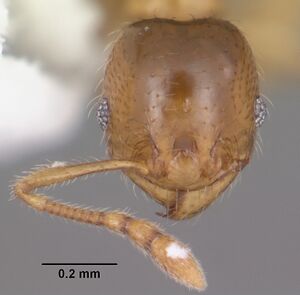 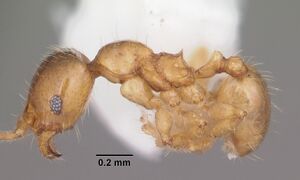 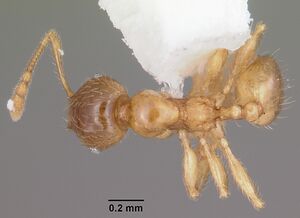 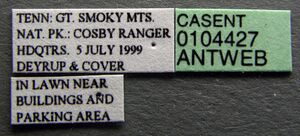
| |
| Worker. Specimen code casent0104427. Photographer April Nobile, uploaded by California Academy of Sciences. | Owned by ABS, Lake Placid, FL, USA. |
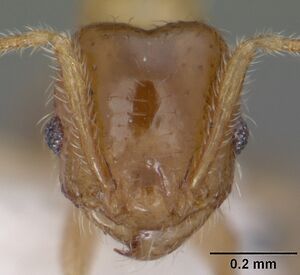 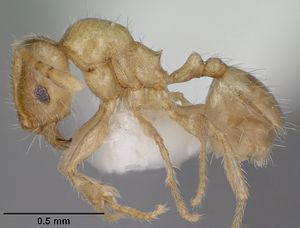 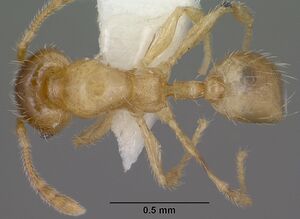 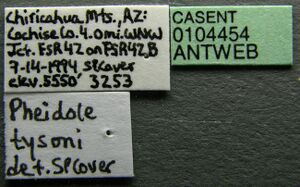
| |
| Worker. Specimen code casent0104454. Photographer Jen Fogarty, uploaded by California Academy of Sciences. | Owned by CAS, San Francisco, CA, USA. |
Major
Images from AntWeb
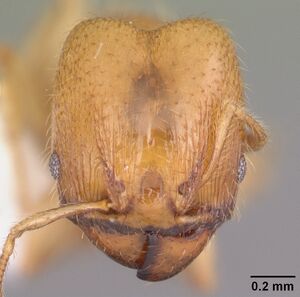 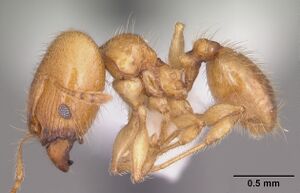 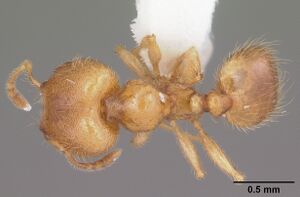 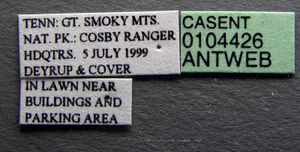
| |
| Worker (major/soldier). Specimen code casent0104426. Photographer April Nobile, uploaded by California Academy of Sciences. | Owned by ABS, Lake Placid, FL, USA. |
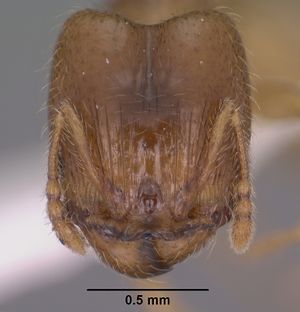 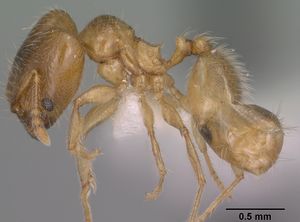 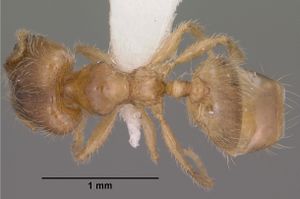 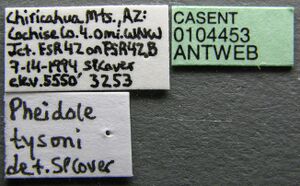
| |
| Worker (major/soldier). Specimen code casent0104453. Photographer Jen Fogarty, uploaded by California Academy of Sciences. | Owned by CAS, San Francisco, CA, USA. |
Queen
Images from AntWeb
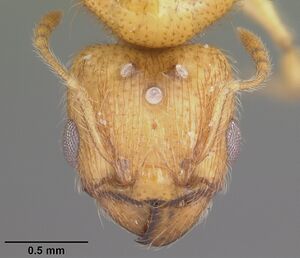 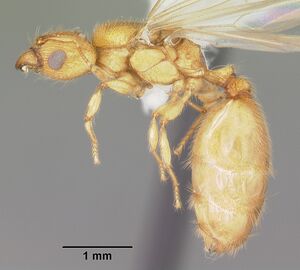 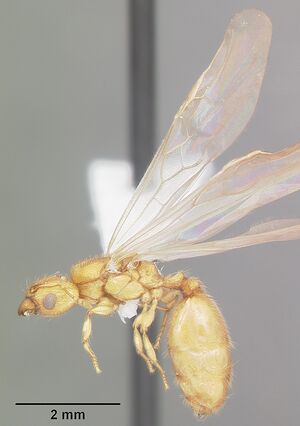 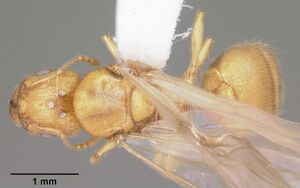 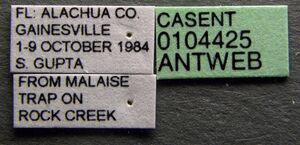
| |
| Queen (alate/dealate). Specimen code casent0104425. Photographer April Nobile, uploaded by California Academy of Sciences. | Owned by ABS, Lake Placid, FL, USA. |
Nomenclature
The following information is derived from Barry Bolton's Online Catalogue of the Ants of the World.
- tysoni. Pheidole tysoni Forel, 1901e: 348 (s.w.m.) U.S.A. See also: Wilson, 2003: 528.
From Wilson (2003): DIAGNOSIS A medium-sized yellow member of the flavens group distinguished by the nearly complete absence of sculpturing on the body, except for longitudinal carinulae on the anterior half of the head capsule of the major and minor, short and faint carinulae on the humerus of the major, and small patches of foveolae on the waist (major) or propodeal dorsum (minor). Propodeal spine short and suberect in both castes. Postpetiolar node of major broad and oval. Vertex of major (center of dorsum of head) with a faint circular brown spot.
Similar to Pheidole amabilis, Pheidole boliviana, Pheidole melastomae, Pheidole mixteca, Pheidole scitula, and especially Pheidole terresi of Hispaniola. Most easily distinguished from the often sympatric Pheidole bicarinata by the absence of sculpture on the sides of the propodeum in the minor. In bicarinata minors these are foveolate.
MEASUREMENTS (mm) Major (figured specimen above): HW 0.94, HL 1.10, SL 0.44, EL 0.12, PW 0.48.Minor (figured specimen above): HW 0.44, HL 0.48, SL 0.42, EL 0.06, PW 0.28.
COLOR Major and minor: concolorous clear medium yellow.
Minor head with a slightly reddish tinge.
Figure. Upper: major. Lower: minor. TENNESSEE: Great Smoky Mountains National Park. Scale bars = 1 mm.
Type Material
Base of Mt. Mitchell, North Carolina, col. Auguste Forel. Musee d'Histoire Naturelle Genève - as reported in Wilson (2003)
Etymology
Named after “M. Tyson,” whose farm was near the type locality. (Wilson 2003)
References
- Wilson, E. O. 2003. Pheidole in the New World: A dominant, hyperdiverse ant genus. Harvard University Press, Cambridge, MA. (page 528, fig. major, minor described)
- Carroll, T.M. 2011. The ants of Indiana (Hymenoptera: Formicidae). M.S. thesis, Purdue University.
- Davis, T. 2009. The ants of South Carolina (thesis, Clemson University).
- Espadaler, X., Santamaria, S. 2012. Ecto- and Endoparasitic Fungi on Ants from the Holarctic Region. Psyche Article ID 168478, 10 pages (doi:10.1155/2012/168478).
- Forel, A. 1901j. Variétés myrmécologiques. Ann. Soc. Entomol. Belg. 45: 334-382 (page 348, soldier, worker, male described)
- Franco, W., Ladino, N., Delabie, J.H.C., Dejean, A., Orivel, J., Fichaux, M., Groc, S., Leponce, M., Feitosa, R.M. 2019. First checklist of the ants (Hymenoptera: Formicidae) of French Guiana. Zootaxa 4674, 509–543 (doi:10.11646/zootaxa.4674.5.2).
- Hosoishi, S., Rahman, M.M., Ogata, K. 2020. First record of Myrmicinosporidium durum (Fungi) parasitizing Pheidole nodus and P. indica (Hymenoptera: Formicidae) from Japan. Japanese Journal of Systematic Entomology, 26 (1): 40–42.
- Ipser, R.M., Brinkman, M.A., Gardner, W.A., Peeler, H.B. 2004. A survey of ground-dwelling ants (Hymenoptera: Formicidae) in Georgia. Florida Entomologist 87: 253-260.
- Ivanov, K. 2019. The ants of Ohio (Hymenoptera, Formicidae): an updated checklist. Journal of Hymenoptera Research 70: 65–87 (doi:10.3897@jhr.70.35207).
- MacGown, J.A., Booher, D., Richter, H., Wetterer, J.K., Hill, J.G. 2021. An updated list of ants of Alabama (Hymenoptera: Formicidae) with new state records. Transactions of the American Entomological Society 147: 961-981 (doi:10.3157/061.147.0409).
- Moody, J. V., Francke, O. F. 1982. The ants (Hymenoptera, Formicidae) of western Texas, Part 1: Subfamily Myrmicinae. Grad. Stud. Tex. Tech Univ. 27: 1–80.
- Pereira, R.M. 2004. Occurrence of Myrmicinosporidium durum in red imported fire ant, Solenopsis invicta, and other new host ants in eastern United States. Journal of Invertebrate Pathology 86: 38-44 (doi:10.1016/j.jip.2004.03.005).
References based on Global Ant Biodiversity Informatics
- Callcott A. M. A., D. H. oi, H. L. Collins, D. F. Williams, and T. C. Lockley. 2000. Seasonal Studies of an Isolated Red Imported Fire Ant (Hymenoptera: Formicidae) Population in Eastern Tennessee. Environmental Entomology, 29(4): 788-794.
- Campbell K. U., and T. O. Crist. 2017. Ant species assembly in constructed grasslands isstructured at patch and landscape levels. Insect Conservation and Diversity doi: 10.1111/icad.12215
- Carroll T. M. 2011. The ants of Indiana (Hymenoptera: Formicidae). Master's Thesis Purdue university, 385 pages.
- Coovert G. A. 2005. The Ants of Ohio (Hymenoptera: Formicidae). Ohio Biological Survey, Inc. 15(2): 1-207.
- Coovert, G.A. 2005. The Ants of Ohio (Hymenoptera: Formicidae) Ohio Biological Survey Bulletin New Series Volume 15(2):1-196
- Cover S. P., and R. A. Johnson. 20011. Checklist of Arizona Ants. Downloaded on January 7th at http://www.asu.edu/clas/sirgtools/AZants-2011%20updatev2.pdf
- Deyrup M., C. Johnson, G. C. Wheeler, J. Wheeler. 1989. A preliminary list of the ants of Florida. Florida Entomologist 72: 91-101
- Deyrup, M. 2003. An updated list of Florida ants (Hymenoptera: Formicidae). Florida Entomologist 86(1):43-48.
- Forster J.A. 2005. The Ants (hymenoptera: Formicidae) of Alabama. Master of Science, Auburn University. 242 pages.
- Frye J. A., T. Frye, and T. W. Suman. 2014. The ant fauna of inland sand dune communities in Worcester County, Maryland. Northeastern Naturalist, 21(3): 446-471.
- General D., and L. Thompson. 2008. Ants of Arkansas Post National Memorial: How and Where Collected. Journal of the Arkansas Academy of Science 62: 52-60.
- Hill J.G. & Brown R. L. 2010. The Ant (Hymenoptera: Formicidae) Fauna of Black Belt Prairie Remnants in Alabama and Mississippi. Southeastern Naturalist. 9: 73-84
- Ipser R. M. 2004. Native and exotic ants (Hymenoptera: Formicidae) of Georgia: Ecological Relationships with implications for development of biologically-based management strategies. Doctor of Philosophy thesis, University of Georgia. 165 pages.
- Ivanov, K. 2019. The ants of Ohio (Hymenoptera, Formicidae): an updated checklist. Journal of Hymenoptera Research 70: 65–87.
- Ivanov K., L. Hightower, S. T. Dash, and J. B. Keiper. 2019. 150 years in the making: first comprehensive list of the ants (Hymenoptera: Formicidae) of Virginia, USA. Zootaxa 4554 (2): 532–560.
- Johnson R. Personnal Database. Accessed on February 5th 2014 at http://www.asu.edu/clas/sirgtools/resources.htm
- MacGown J. A. 2015. Report on the ants collected on Spring Island, Beaufort County, South Carolina. A report submitted to Spring Island Nature Preserve, May 2015. Mississippi Entomological Museum Report #2015-01. 8 pp
- MacGown J. A., J. G. Hill, R. L. Brown, T. L. Schiefer, J. G. Lewis. 2012. Ant diversity at Noxubee National Wildlife Refuge in Oktibbeha, Noxubee, and Winston Counties, Mississippi. Mississippi Agricultural and Forestry Experiment Station Bulletin 1197: 1-30
- MacGown J. A., J. G. Hill, and R. L. Brown. 2010. Native and exotic ant in Mississippi state parks. Proceedings: Imported Fire Ant Conference, Charleston, South Carolina, March 24-26, 2008: 74-80.
- MacGown J. A., and R. L. Brown. 2006. Survey of the ants (Hymenoptera: Formicidae) of the Tombigbee National Forest in Mississippi. Journal of the Kansas Entomological Society 79(4):325-340.
- MacGown, J.A and J.A. Forster. 2005. A preliminary list of the ants (Hymenoptera: Formicidae) of Alabama, U.S.A. Entomological News 116(2):61-74
- MacGown, J.A. and R.L. Brown. 2006. Observations on the High Diversity of Native Ant Species Coexisting with Imported Fire Ants at a Microspatial Scale in Mississippi. Southeastern Naturalist 5(4):573-586
- MacGown, J.A. and R.L. Brown. 2006. Survey of the ants (Hymenoptera: Formicidae) of the Tombigbee National Forest in Mississippi. Journal of the Kansas Entomological Society 79(4):325-340.
- MacGown, J.A., J.G. Hill, R.L. Brown and T.L. 2009. Ant Diversity at Noxubee National Wildlife Refuge in Oktibbeha, Noxubee, and Winston Counties, Mississippi Report #2009-01. Schiefer. 2009.
- Macgown J. A., S. Y. Wang, J. G. Hill, and R. J. Whitehouse. 2017. A List of Ants (Hymenoptera: Formicidae) Collected During the 2017 William H. Cross Expedition to the Ouachita Mountains of Arkansas with New State Records. Transactions of the American Entomological Society, 143(4): 735-740.
- Moody J. V., and O. F. Francke. 1982. The Ants (Hymenoptera, Formicidae) of Western Texas Part 1: Subfamily Myrmicinae. Graduate Studies Texas Tech University 27: 80 pp.
- Naves M. A. 1985. A monograph of the genus Pheidole in Florida, USA (Hymenoptera: Formicidae). Insecta Mundi 1: 53-90
- Nuhn, T.P. and C.G. Wright. 1979. An Ecological Survey of Ants (Hymenoptera: Formicidae) in a Landscaped Suburban Habitat. American Midland Naturalist 102(2):353-362
- O'Keefe S. T., J. L. Cook, T. Dudek, D. F. Wunneburger, M. D. Guzman, R. N. Coulson, and S. B. Vinson. 2000. The Distribution of Texas Ants. The Southwestern Entomologist 22: 1-92.
- Roeder K. A., and D. V. Roeder. 2017. The Pheidole (Hymenoptera: Formicidae) of Oklahoma: new species records and distributional notes. Check List 13(2): 2071.
- Toennisson T. A., N. J. Sanders, W. E. Klingeman, and K. M. Vail. 2011. Influences on the Structure of Suburban Ant (Hymenoptera: Formicidae) Communities and the Abundance of Tapinoma sessile. Environ. Entomol. 40(6): 1397-1404.
- Van Pelt A., and J. B. Gentry. 1985. The ants (Hymenoptera: Formicidae) of the Savannah River Plant, South Carolina. Dept. Energy, Savannah River Ecology Lab., Aiken, SC., Report SRO-NERP-14, 56 p.
- Wheeler W. M. 1904. The ants of North Carolina. Bulletin of the American Museum of Natural History. 20: 299-306.
- Wheeler, G.C. and J. Wheeler. 1985. A checklist of Texas ants. Prairie Naturalist 17:49-64.
- Wilson, E.O. 2003. Pheidole in the New World: A Dominant, Hyperdiverse Genus. Harvard University Press



